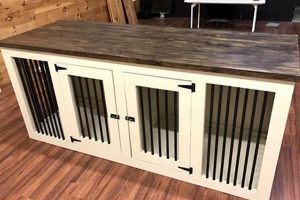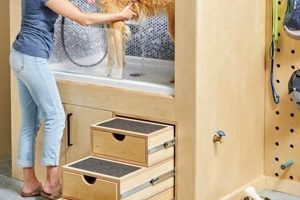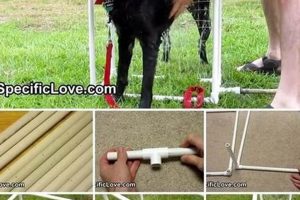The construction of canine shelters utilizing repurposed wooden platforms represents a sustainable and economical approach to pet care. These structures, often built from reclaimed materials, provide a secure and comfortable outdoor space for domestic animals. The practice involves disassembling, modifying, and reassembling the platforms into a miniature dwelling, customized to suit the specific needs and size of the animal.
This method offers several advantages, including cost savings compared to commercially produced alternatives, environmental responsibility through material reuse, and customization options. The use of reclaimed lumber reduces waste, diminishing the demand for new timber production. Moreover, constructing a shelter allows for tailored design, ensuring optimal size, insulation, and aesthetic integration with the surrounding environment. Historically, the practice of utilizing reclaimed materials for animal housing has been driven by economic necessity and resourcefulness.
The following sections will detail considerations for selecting appropriate materials, safe construction techniques, design principles for optimal animal comfort, and methods for weatherproofing to ensure longevity and protection from the elements.
Construction Advice
The following are guidelines to ensure a structurally sound and safe outdoor enclosure for canine companions.
Tip 1: Material Inspection is Paramount. Scrutinize all reclaimed platforms for protruding nails, staples, or splinters. Remove or flatten any hazards to prevent injury to the animal.
Tip 2: Prioritize Structural Integrity. Select platforms that exhibit minimal decay or damage. Load-bearing components should be free from significant cracks or warps, ensuring the shelter’s long-term stability.
Tip 3: Employ Proper Fastening Techniques. Securely join sections with weather-resistant screws and construction adhesive. This will resist separation from environmental stressors and the animal’s movements.
Tip 4: Consider Elevated Flooring. Implementing a raised floor minimizes contact with damp ground, reducing the risk of moisture damage and improving thermal regulation within the enclosure.
Tip 5: Ensure Adequate Ventilation. Incorporate ventilation openings to facilitate airflow. These vents must be strategically placed to prevent drafts while mitigating moisture buildup and maintaining air quality.
Tip 6: Weatherproof Exterior Surfaces. Apply a non-toxic sealant or paint to protect the wood from rain, snow, and sun exposure. Regular reapplication will extend the structure’s lifespan.
Tip 7: Design for Appropriate Size. Dimensions should allow the animal to stand, turn around, and lie down comfortably. Omit excessive space to conserve heat in colder climates.
Adherence to these recommendations promotes a secure, comfortable, and durable outdoor shelter for the animal. Prioritizing safety and structural integrity during construction is critical.
The subsequent section will address design considerations and customization options to further enhance the shelter’s functionality and aesthetics.
1. Dimensions
The dimensions of a shelter constructed from repurposed wooden platforms are a foundational determinant of its suitability and functionality for a canine occupant. Improper sizing can lead to discomfort, inadequate protection from environmental elements, and, in extreme cases, health risks. The correlation between the animal’s size and the internal dimensions of the structure is a direct cause-and-effect relationship. A shelter too small restricts movement and prevents comfortable resting positions, potentially leading to joint stiffness or anxiety. Conversely, an excessively large shelter diminishes its effectiveness in conserving the animal’s body heat during cold weather.
Examples of dimensional miscalculations abound. A common error is constructing a shelter with insufficient headroom, forcing the animal to crouch continuously. Another involves an overly expansive interior cavity, which becomes difficult for the animal to warm during winter months. Optimal dimensions typically allow the animal to stand comfortably, turn around freely, and lie down fully extended. Furthermore, the entrance should be appropriately sized to prevent drafts while facilitating easy access. Shelter dimensions are also related to its potential portability. Larger structures may be heavier and more difficult to move.
In summary, careful consideration of dimensions is paramount to the success of a canine shelter project utilizing repurposed wooden platforms. Accurate measurement of the animal and thoughtful design based on climate considerations are essential. Neglecting these dimensional aspects compromises the shelter’s intended function and ultimately detracts from the animal’s well-being. The careful selection of platform materials and accurate cutting to provide optimum dimensions are critical.
2. Safety
Safety constitutes a primary concern in the design and construction of canine shelters from repurposed wooden platforms. The inherent nature of reclaimed materials introduces potential hazards that necessitate meticulous attention. Failure to address these safety considerations can directly result in physical harm to the animal. The presence of protruding nails, splinters, or staples on the wooden platforms creates immediate sources of injury, ranging from minor cuts to severe puncture wounds. Similarly, the use of platforms treated with harmful chemicals or preservatives can lead to skin irritation, respiratory problems, or even systemic toxicity. Furthermore, structurally unsound platforms pose a risk of collapse, potentially causing blunt-force trauma.
Mitigating these risks requires a systematic approach to material inspection and preparation. All reclaimed platforms must undergo a thorough examination to identify and remove any potentially hazardous elements. This includes the careful extraction of nails, staples, and other fasteners, as well as the sanding of rough surfaces to eliminate splinters. Furthermore, platforms should be assessed for structural integrity, with any weakened or decayed components replaced. The selection of appropriate finishes is also critical. Non-toxic paints, stains, and sealants should be used to protect the wood from the elements without posing a health risk to the animal. A real-world example underscores the importance of this concern. An individual constructed a shelter, omitting the removal of staples. As a result, the animal received puncture injuries when exiting the shelter.
In summary, the safety of a shelter is paramount and necessitates a proactive and diligent approach to material preparation and construction. Thorough inspection, hazard removal, and the use of safe materials are essential steps in ensuring the well-being of the animal. Neglecting these safety measures can have direct and detrimental consequences, negating the benefits of providing shelter. Therefore, prioritizing safety must be an integral aspect of every construction project involving repurposed wooden platforms intended for canine housing.
3. Materials
The selection of materials is a critical determinant of the success, safety, and longevity of a shelter constructed from repurposed wooden platforms. Material choice directly impacts the shelter’s structural integrity, weather resistance, and suitability for the animal inhabiting it. The following details specific facets of materials relevant to this construction method.
- Platform Wood Composition
The type of wood comprising the platform is a primary consideration. Hardwoods, such as oak or maple, offer greater strength and durability compared to softwoods like pine. However, hardwoods are often heavier and more difficult to work with. The wood’s treatment history, including any chemical preservatives, must be carefully evaluated to ensure the absence of toxic substances that could harm the animal. For instance, platforms treated with chromated copper arsenate (CCA) should be avoided due to the potential for arsenic leaching.
- Fasteners and Adhesives
The hardware employed to join sections significantly influences the structural integrity. Weather-resistant screws and bolts are preferable to nails, as they provide a more secure and durable connection. Construction adhesive, specifically formulated for exterior use, can further enhance joint strength and prevent water infiltration. An example of improper fastener selection is using drywall screws, which are prone to corrosion and shear failure in outdoor environments.
- Weatherproofing Agents
Protection from the elements is essential for extending the shelter’s lifespan and maintaining a comfortable environment for the animal. Weatherproofing agents, such as paints, stains, and sealants, create a barrier against moisture, ultraviolet radiation, and temperature fluctuations. It is crucial to select non-toxic, pet-safe products to avoid potential health risks. Linseed oil, for instance, can be used but must be fully cured to prevent ingestion hazards.
- Insulation (Optional)
In colder climates, insulation materials can enhance the shelter’s thermal performance. Options include rigid foam boards, fiberglass batts, or recycled textile materials. Proper installation is critical to prevent moisture accumulation and mold growth. The insulation materials also must be inaccessible to the animal. A common error is leaving exposed insulation, which the animal may chew on.
In conclusion, the successful construction of a shelter from repurposed wooden platforms hinges on the careful selection and appropriate application of materials. Prioritizing durable, safe, and weather-resistant components ensures a comfortable and secure environment for the animal and enhances the structure’s longevity. Failure to consider these material aspects compromises the project’s success and potentially endangers the animal’s well-being. Thoughtful selection of materials has a direct impact to its success and longevity.
4. Weatherproofing
Weatherproofing constitutes a fundamental aspect of constructing a canine shelter from reclaimed wooden platforms. The connection between material protection and structural longevity is direct. Exposure to environmental elements, such as rain, snow, and solar radiation, accelerates the degradation of untreated wood, leading to decay, warping, and ultimately, structural failure. Consequently, a shelter lacking adequate weatherproofing measures will exhibit a significantly reduced lifespan and fail to provide consistent protection to the animal.
The integration of weatherproofing techniques into the construction process involves several critical steps. The application of a water-resistant sealant or paint creates a protective barrier against moisture penetration, mitigating the risk of rot and fungal growth. Proper sealing of joints and seams prevents water infiltration, further safeguarding the wood from decay. The use of roofing materials, such as asphalt shingles or metal sheeting, provides a durable and weather-resistant covering for the shelter’s roof. For example, the impact of prolonged exposure to moisture on untreated wood is evident in outdoor decking, which can exhibit signs of decay within a few years, in contrast to treated decking that can last for decades. Similarly, an unprotected shelter will require significantly more frequent repairs and maintenance than a weatherproofed one. Regular inspection and maintenance are crucial. Recoating or resealing may be required over time.
In conclusion, weatherproofing is not merely an optional add-on but rather an essential component of any canine shelter project utilizing reclaimed wooden platforms. The proactive implementation of appropriate weatherproofing measures directly correlates with the shelter’s durability, longevity, and ability to provide consistent protection to the animal. Neglecting weatherproofing considerations can result in premature structural failure, necessitating costly repairs or replacement, and potentially compromising the animal’s well-being. The durability, stability and safety for the dog is related to how well it is weatherproofed.
5. Ventilation
Ventilation represents a critical design element in the construction of canine shelters from reclaimed wooden platforms. Inadequate airflow within the structure can lead to a multitude of adverse effects on the animal’s health and well-being. Elevated humidity levels promote the growth of mold and mildew, creating an unhealthy environment and potentially exacerbating respiratory conditions. Stagnant air can trap odors and contribute to the accumulation of harmful gases, such as ammonia, released from the animal’s waste. Furthermore, insufficient ventilation can hinder temperature regulation, causing the shelter to become excessively hot in summer and excessively cold in winter.
Proper ventilation strategies involve the incorporation of strategically placed openings to facilitate airflow. These openings should be sized and positioned to allow for cross-ventilation, enabling the exchange of stale air with fresh air. For example, vents located near the roof can allow warm, moist air to escape, while vents placed lower can draw in cooler air. The design must also account for prevailing wind patterns to maximize ventilation efficiency. Inadequate planning can lead to drafts, which can be detrimental to the animal’s health, particularly during cold weather. The location of the entryway should be carefully considered to minimise exposure to strong winds while also facilitating airflow. Real-world applications demonstrate the impact of ventilation design; a shelter with improperly located vents may trap heat and moisture, whereas a well-ventilated shelter can maintain a comfortable and healthy internal environment, even under extreme conditions.
In conclusion, the design and implementation of effective ventilation strategies are paramount to the success of a shelter project utilizing reclaimed wooden platforms. Prioritizing airflow mitigates the risks of mold growth, odor accumulation, and temperature extremes, contributing to a healthier and more comfortable environment for the animal. Overlooking ventilation concerns undermines the shelter’s intended function and compromises the animal’s well-being. The cost for proper ventlation consideration is low but the benifit is high for dog health.
6. Durability
The durability of a canine shelter constructed from repurposed wooden platforms directly impacts its long-term utility and cost-effectiveness. A lack of durability results in premature structural failure, requiring frequent repairs or complete replacement, thereby negating the economic and environmental benefits associated with using reclaimed materials. The connection between construction techniques and material choices to resistance against environmental stressors is critical. Proper joint construction, appropriate wood preservatives, and protective coatings significantly extend the shelter’s lifespan. Conversely, neglecting these factors diminishes the structure’s ability to withstand weather conditions, physical wear, and the animal’s activity.
Examples illustrating the importance of durability are readily apparent. Shelters constructed with untreated wood exposed to rain and snow exhibit signs of rot and decay within a relatively short period. Similarly, shelters lacking secure joinery are prone to collapse under the animal’s weight or during strong winds. The economic implications are significant; a poorly constructed shelter may require replacement within a few years, whereas a durable shelter can provide reliable protection for a decade or more. Practical application involves selecting high-quality, weather-resistant materials, employing robust construction methods, and implementing a regular maintenance schedule. Real-world assessments confirm that shelters prioritizing durability exhibit lower long-term costs and provide superior protection and shelter.
In summary, durability is not a supplementary attribute but rather an essential component of a canine shelter project utilizing reclaimed wooden platforms. Prioritizing robust materials, sound construction practices, and protective finishes directly translates to increased longevity, reduced maintenance costs, and enhanced animal welfare. Challenges in achieving durability include sourcing appropriate materials and employing skilled construction techniques. Overcoming these challenges is vital to realizing the full potential of shelters constructed from repurposed wooden platforms, ensuring their long-term utility and minimizing their environmental impact.
Frequently Asked Questions
The following addresses common inquiries regarding the design, construction, and maintenance of canine shelters utilizing reclaimed wooden platforms. These questions are designed to provide clarity and guidance on best practices for ensuring animal safety and structural longevity.
Question 1: What types of platforms are unsuitable for canine shelter construction?
Platforms treated with chemical preservatives, particularly those containing chromated copper arsenate (CCA), should be avoided due to the potential for leaching and toxicity. Platforms exhibiting extensive decay, mold, or structural damage are also unsuitable.
Question 2: How can sharp edges and protrusions be safely eliminated from reclaimed platforms?
Sharp edges can be smoothed with a sander or plane. Protruding nails and staples should be removed with a hammer and pliers. Any remaining holes should be filled with wood filler and sanded smooth.
Question 3: What are the recommended dimensions for a canine shelter constructed from platforms?
The internal dimensions should allow the animal to stand comfortably, turn around freely, and lie down fully extended. The entrance should be sized appropriately to prevent drafts while allowing easy access.
Question 4: What types of weatherproofing agents are safe for use on canine shelters?
Non-toxic, pet-safe paints, stains, and sealants specifically formulated for exterior use are recommended. Products should be thoroughly dried and cured before the animal is allowed access to the shelter.
Question 5: How can adequate ventilation be ensured in a shelter constructed from platforms?
Strategically placed vents, typically near the roof and floor, allow for cross-ventilation. The size and placement of vents should be adjusted to account for local climate conditions and prevailing winds.
Question 6: What maintenance procedures are necessary to ensure the long-term durability of a platform-based canine shelter?
Regular inspection for signs of damage, decay, or pest infestation is essential. Weatherproofing agents should be reapplied periodically. Any damaged components should be promptly repaired or replaced.
Adherence to these guidelines contributes to the creation of a safe, comfortable, and durable shelter for canine companions. Prioritizing animal welfare and structural integrity remains paramount.
The next section will explore advanced design considerations and customization options to further enhance the shelter’s functionality and aesthetics.
DIY Pallet Dog House
The foregoing exploration has detailed critical considerations for constructing canine shelters from repurposed wooden platforms. Key points include the imperative of material safety, structural integrity, adequate weatherproofing, and proper ventilation. Dimensions, material selection, and construction techniques directly influence the shelter’s durability and its ability to provide a secure and comfortable environment for the animal. This method presents both economic and environmental benefits by repurposing discarded materials and reducing the demand for new resources. Proper planning and execution are paramount to mitigate inherent risks associated with reclaimed lumber.
The creation of a “diy pallet dog house” extends beyond simple construction. It represents a commitment to responsible resource utilization and animal welfare. As the focus on sustainability grows, this approach will likely gain increased traction. Individuals are encouraged to implement best practices, prioritizing safety and longevity to ensure optimal outcomes. A continued adherence to the principles outlined is vital to maximize success and animal well-being.







